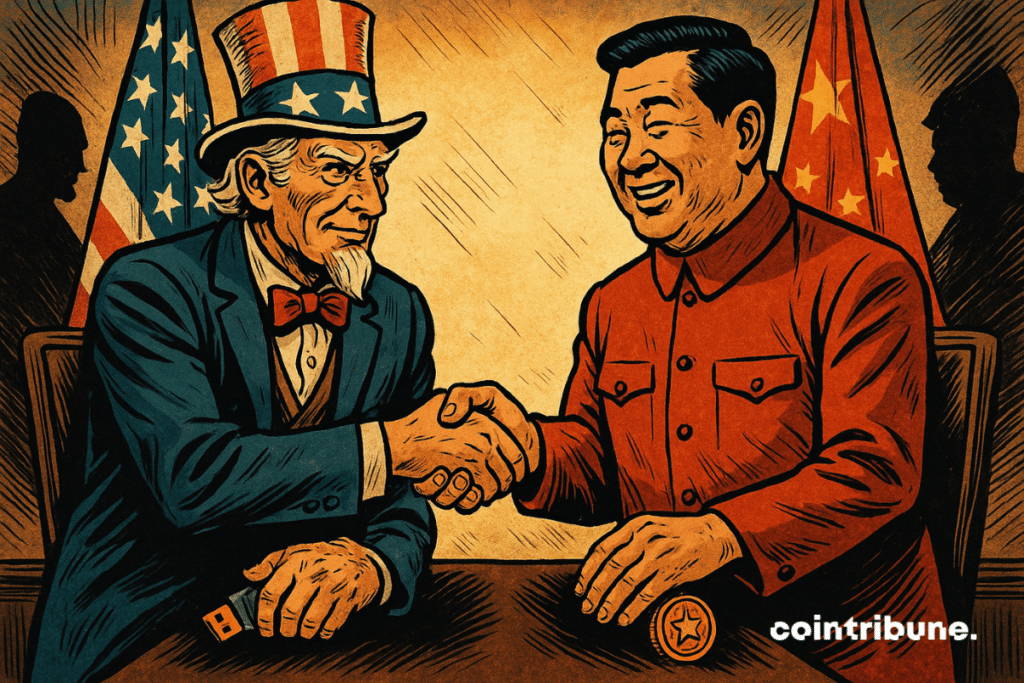USA-China: A Fragile 90-Day Truce Amid Global Economic Uncertainty
Behind the tariff war initiated by Donald Trump lies a logic more opaque than it seems. Supposed to protect the American economy, this strategy also seems designed to appeal to a privileged electorate. Why target so many sectors? Why maintain intense tariff pressure? While the slogans speak of sovereignty, the choices sometimes betray much more targeted interests. And now that the surtaxes are on pause, the real question remains: what is Trump really seeking?

In Brief
- China-US surtaxes suspended for 90 days after secret negotiations in Geneva.
- The global logistics economy remains disrupted despite the temporary easing of US tariffs.
- American households still face rising prices on essential imported goods.
- China still refuses to change its state-directed economic model under US pressure.
Historic Suspension of Surtaxes Between the United States and China
On the night of May 12, at 6 am French time, most of the punitive customs surtaxes between China and the United States were suspended. This decision marks an unprecedented lull in the trade war. Washington reduced its surtaxes from 145% to 30%, while Beijing lowers theirs to 10%. Donald Trump hailed this advance on Fox News:
We have the framework for a very, very strong agreement with China.
Financial markets immediately reacted. US indexes surged. But this suspension is limited to 90 days. It leaves the hard points of the conflict unresolved. The discussions in Geneva allowed this pause but did not settle the major structural differences.
China still refuses any changes to its export-centered economic model. Fentanyl remains a major bone of contention. The risk of a resumption of surtaxes already looms over the end of summer.
Tariff War: A Diplomatic Lever or an Economic Trap?
The Geneva agreement is presented as a turning point. It is based on a temporary tariff truce. But beyond the tariff reductions, tensions remain high. The true tensions concern semiconductors, strategic metals, and repressive measures against opioids. Analysts remain cautious. “The jury has not yet delivered its verdict,” warns Greta Peisch.
The timeframe is short. Negotiations are complex. Some voices call to reassess Trump’s entire economic strategy. His method? Using tariffs as a geopolitical lever. But by acting this way, doesn’t he risk compromising the global economy? This pause, spectacular as it may be, could be only a diplomatic respite before a new escalation.
Supply Chains Disrupted by the Trade War
The tariff war directly affected business economies. Chinese commerce giants such as Shein or Temu have seen their logistics disrupted. The de minimis threshold was lowered, temporarily increasing the conditions for direct imports.
But uncertainty hangs in the air. Companies have stockpiled massively in the United States. Amazon revised its supply flows. US customs struggle to keep up. The director of the WTO worries:
A global decoupling would be a catastrophe.
The global supply chain depends on a fluid economy. Yet current rules encourage fragmentation. In Asia, factories are reorganizing their production. In the United States, some companies are revising their industrial strategy. But for how much longer? Delivery times are lengthening, costs are skyrocketing. And what about the consumer? He pays, silently.
Household Economy Facing Tariffs: Who Really Pays?
On the side of American households, effects are already felt. Prices are rising on the shelves. Economists sound the alarm on this pressure. “This remains a huge disruption for essential goods“, alerts Clark Packard.
The applied taxation primarily penalizes low-income households. In certain states, 48% of taxed parcels go to the poorest areas. Measures also target fentanyl, but with no net result. Medication deliveries are slowed. Even surgical gloves hit 100% tariffs. Here are some key figures:
- 30%: current customs rate on most Chinese imports;
- 145%: peak reached in April for taxes;
- 3%: share of Sino-American trade in global trade;
- 8.1%: increase in Chinese exports in April;
- 18%: decrease in Chinese imports into the United States.
The impact is clear. And it is only beginning.
A Pressure Strategy That Divides Analysts
While cryptos like Ethereum rise, the global economy is suspended on future decisions in Washington. Experts speak of an unprecedented commercial diplomacy. Trump uses tariffs as a permanent negotiation lever. But this is not enough. The agreement does not resolve intellectual property issues. Beijing remains inflexible.
“China will not change its economic model in 90 days“, asserts Robert Kuttner. The fentanyl crisis remains at the heart of tensions. Trump maintains 20% surtaxes related to this issue. The trade war goes beyond the economy. It touches security.
Switzerland attempts mediation. Europe remains withdrawn. Negotiations with India and Japan are suspended. Each discussion becomes more difficult. The consensus cracks. Trump’s strategy opens dialogues but delays convincing on the substance.
Trade tensions have overheated markets and disrupted the economy in the United States and elsewhere. Yet an unexpected drop in US inflation surprised analysts. Should this be seen as a strategic victory or a simple cycle effect? The economy remains at the heart of this global standoff. The next chapters will be written on multiple fronts.
Maximize your Cointribune experience with our "Read to Earn" program! For every article you read, earn points and access exclusive rewards. Sign up now and start earning benefits.
La révolution blockchain et crypto est en marche ! Et le jour où les impacts se feront ressentir sur l’économie la plus vulnérable de ce Monde, contre toute espérance, je dirai que j’y étais pour quelque chose
The views, thoughts, and opinions expressed in this article belong solely to the author, and should not be taken as investment advice. Do your own research before taking any investment decisions.